
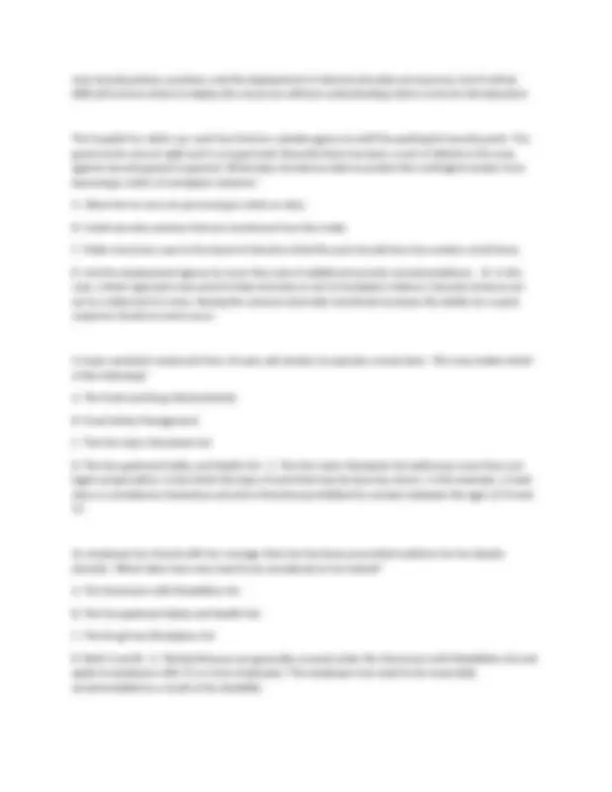
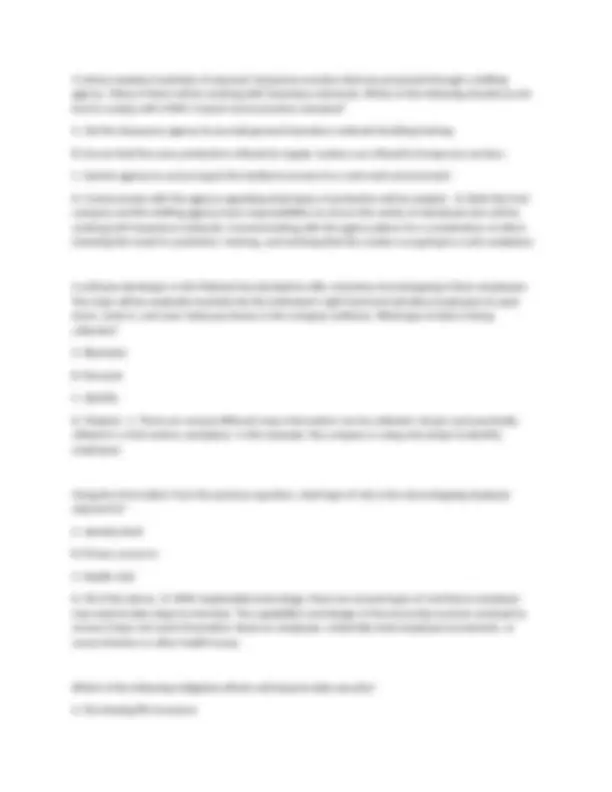
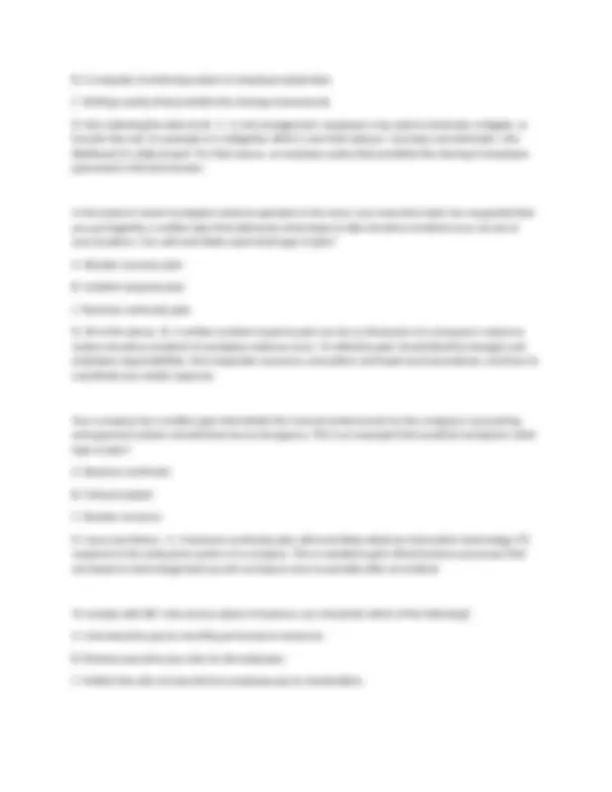
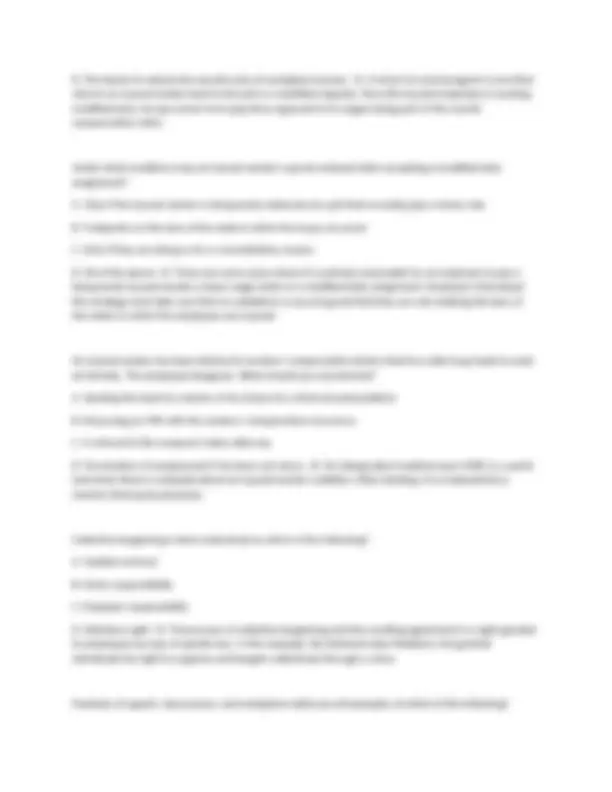
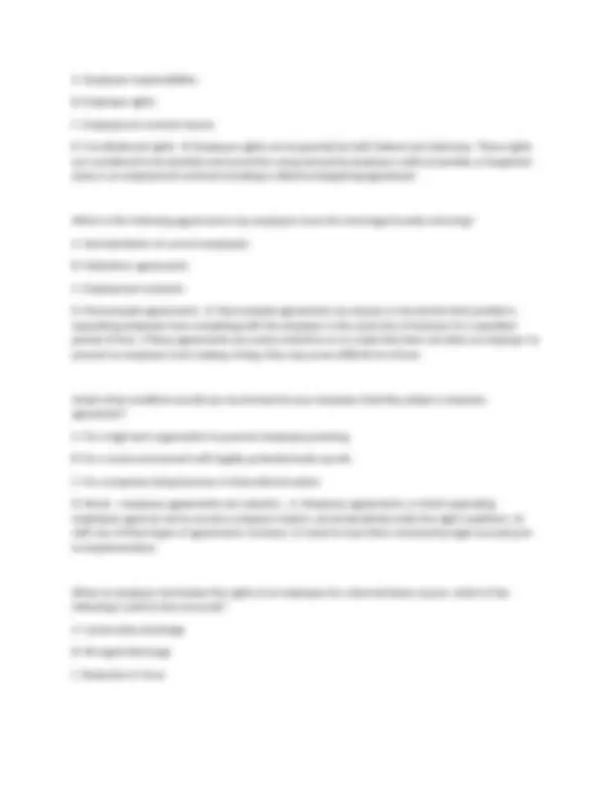
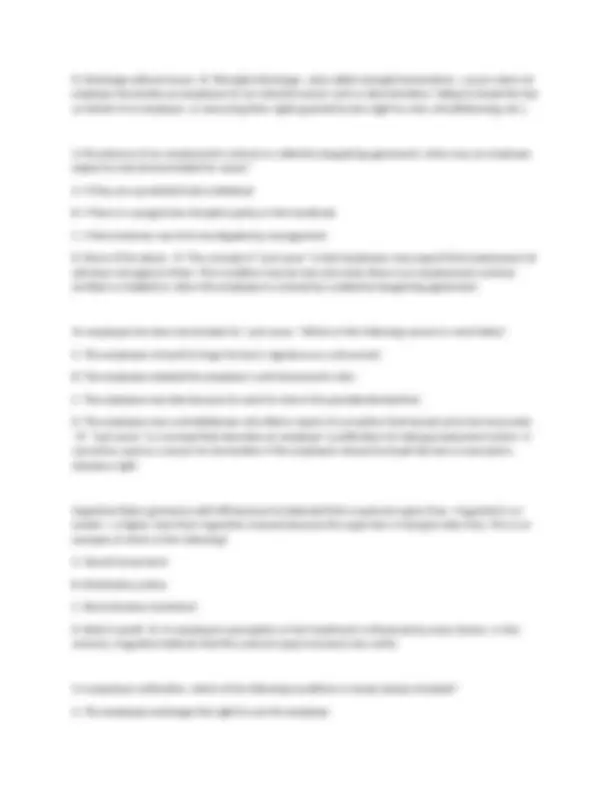
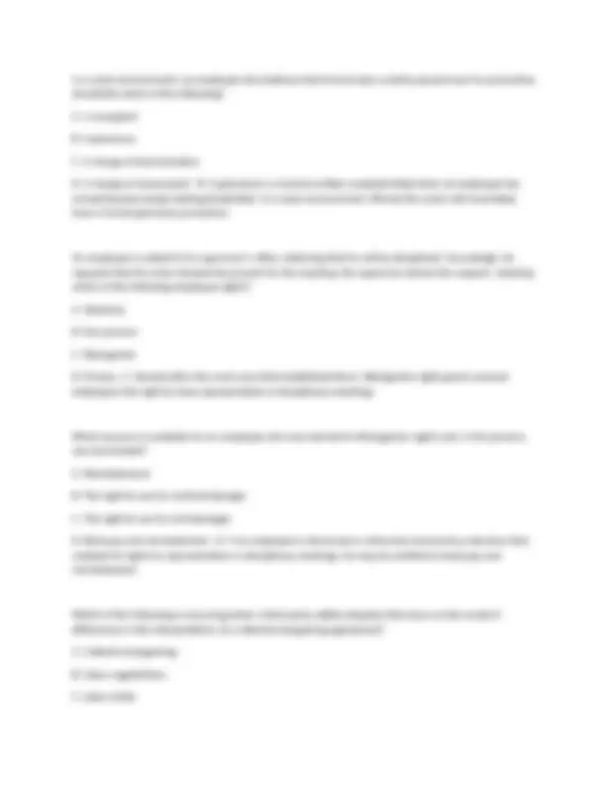
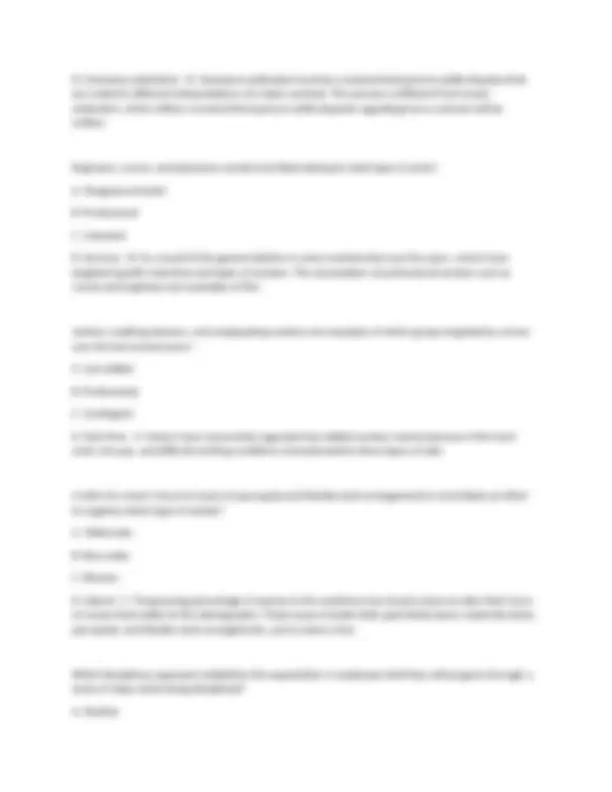
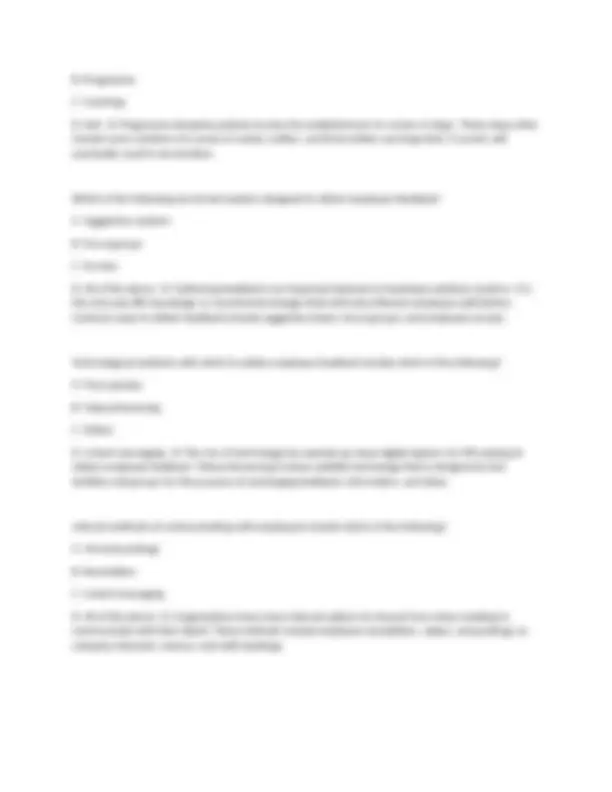
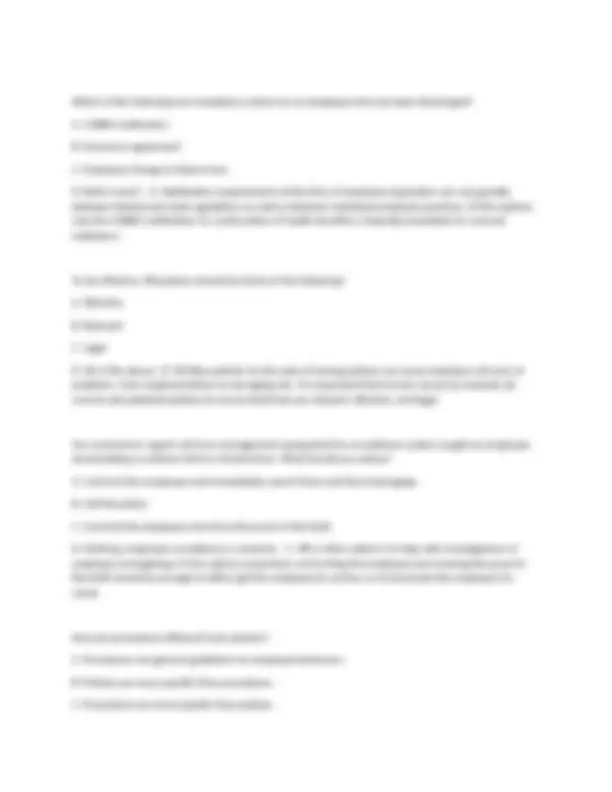
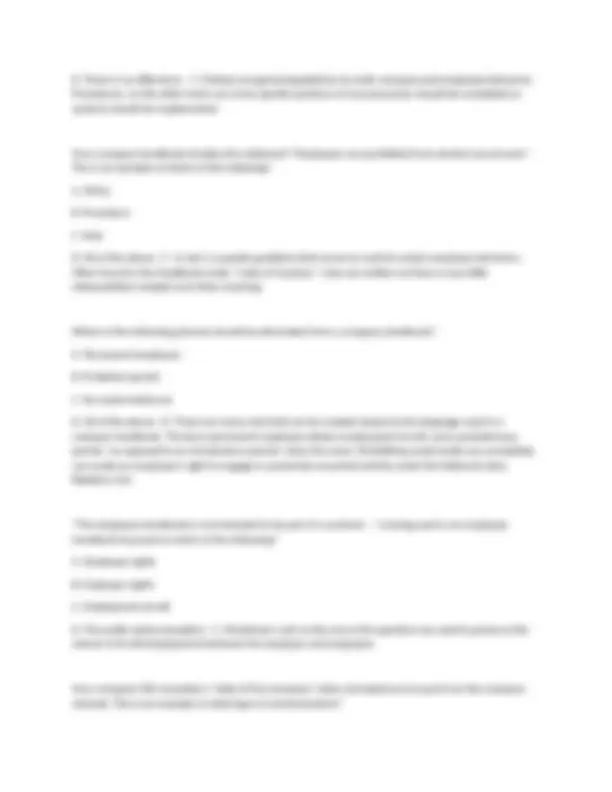
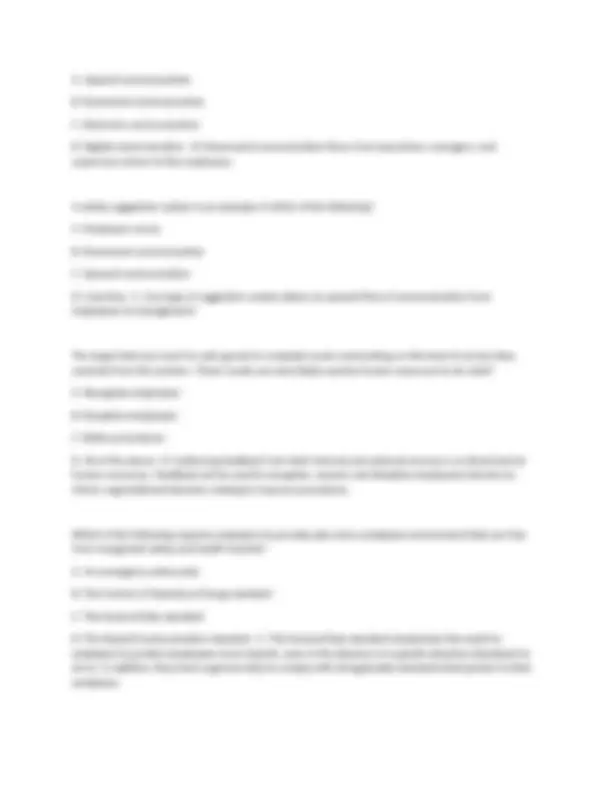
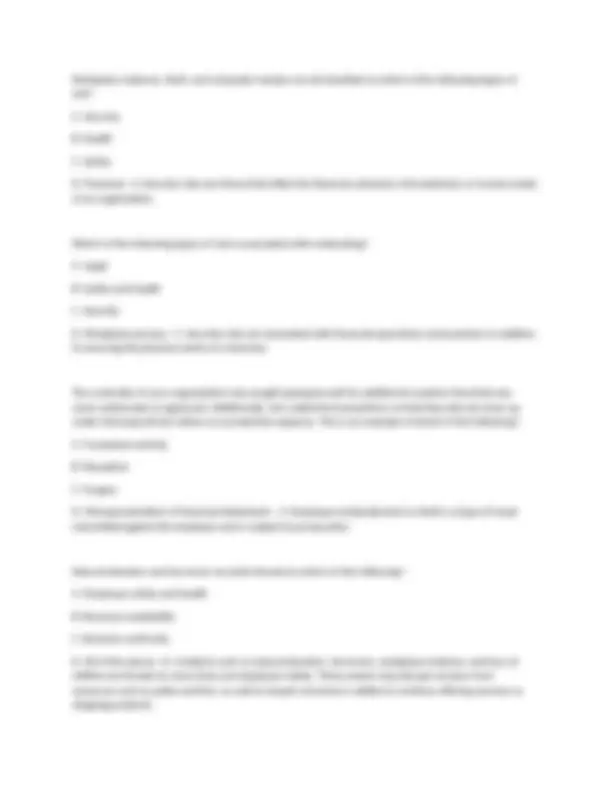
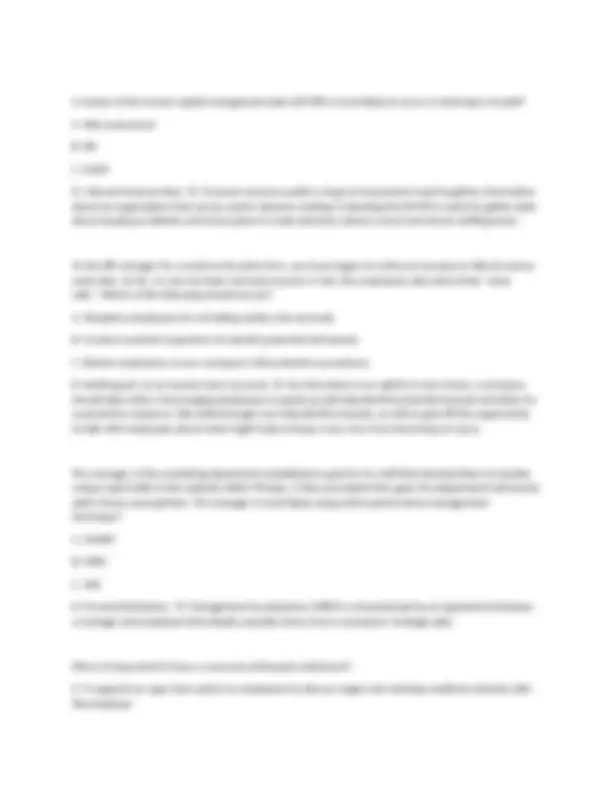
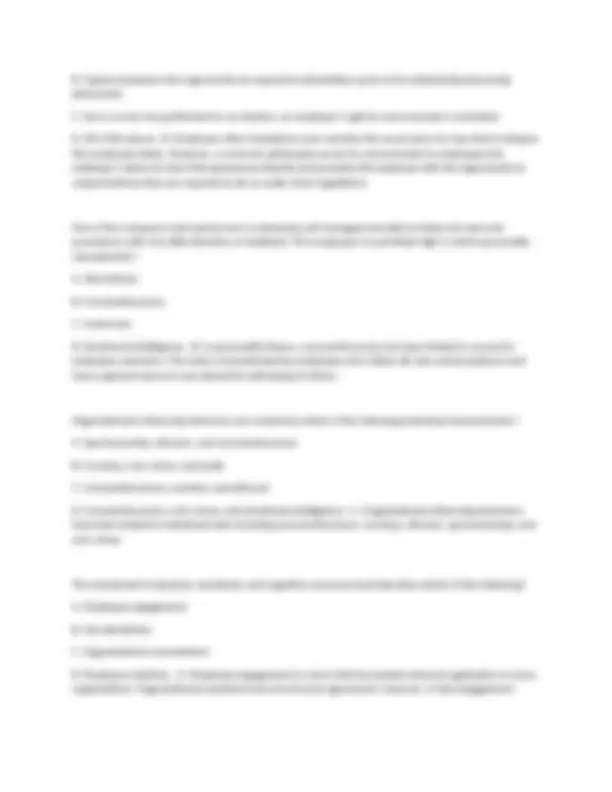
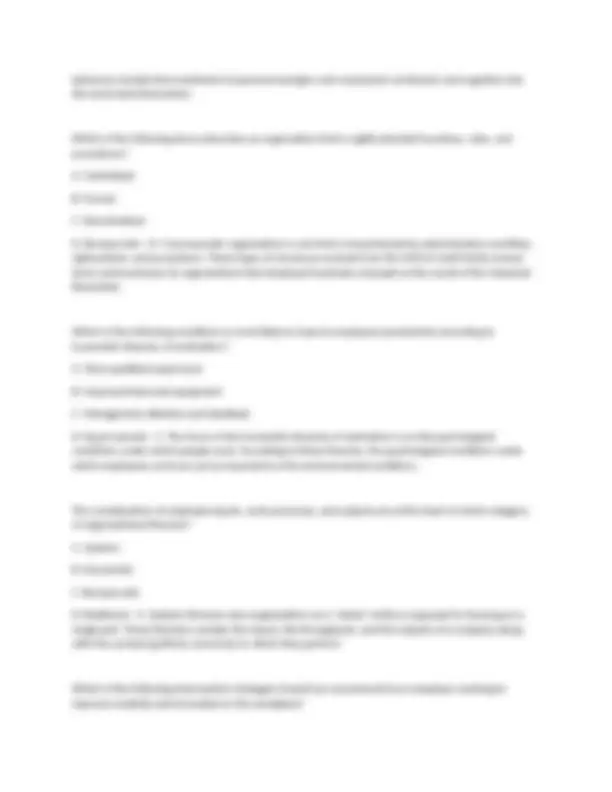
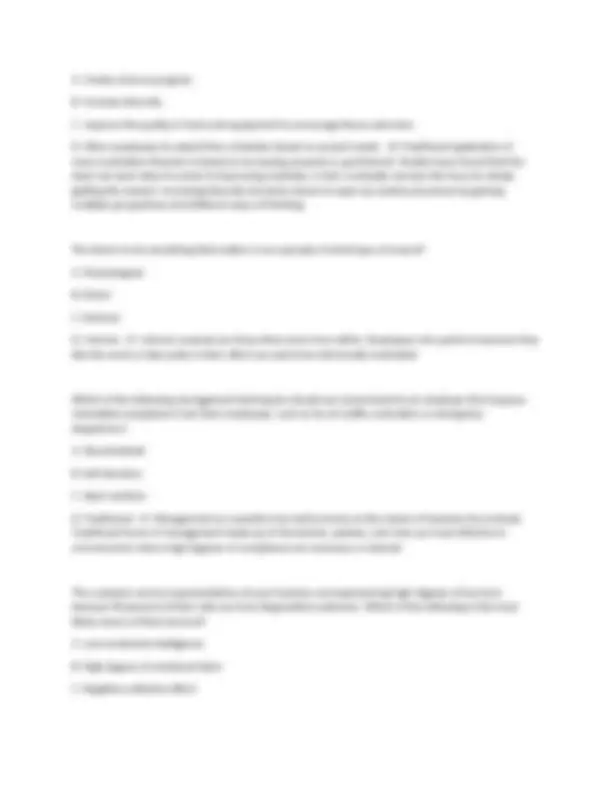
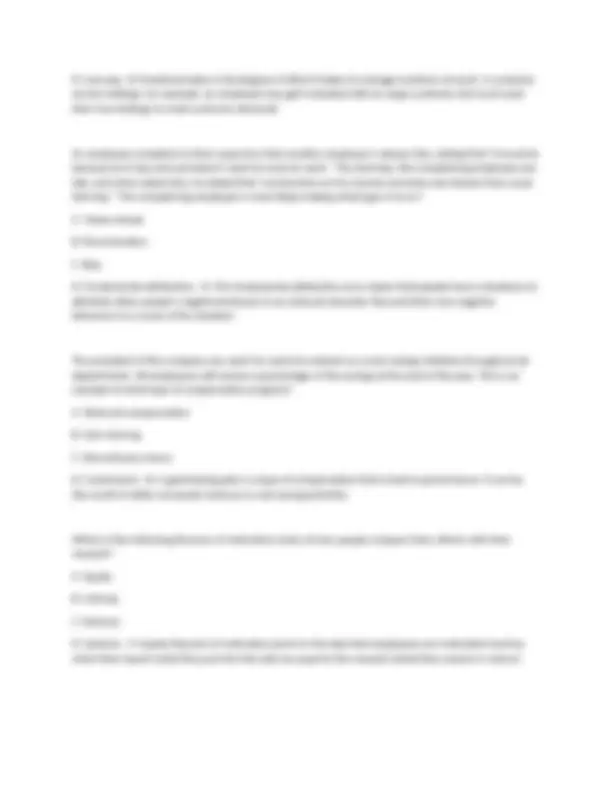
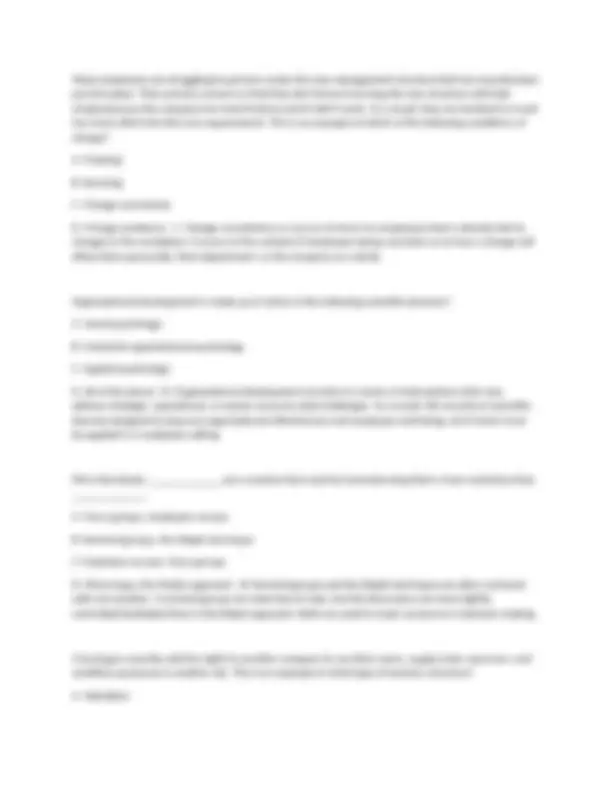
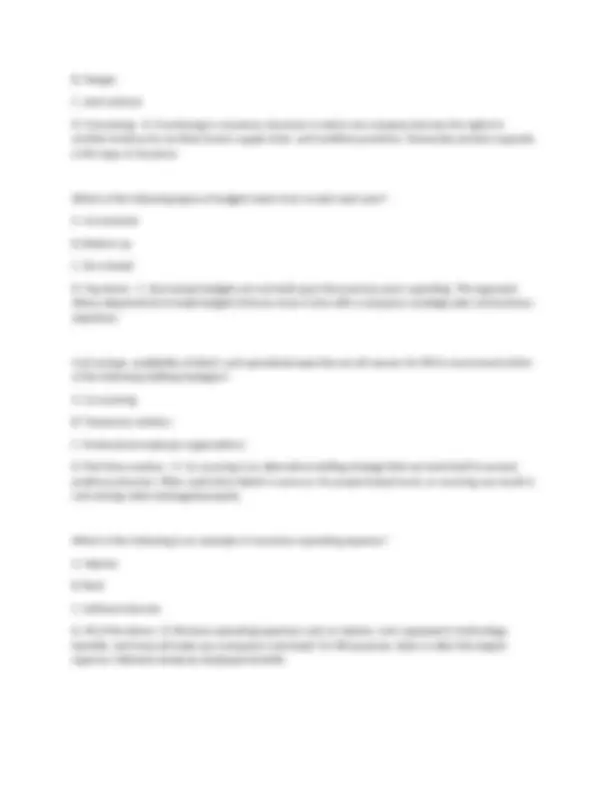
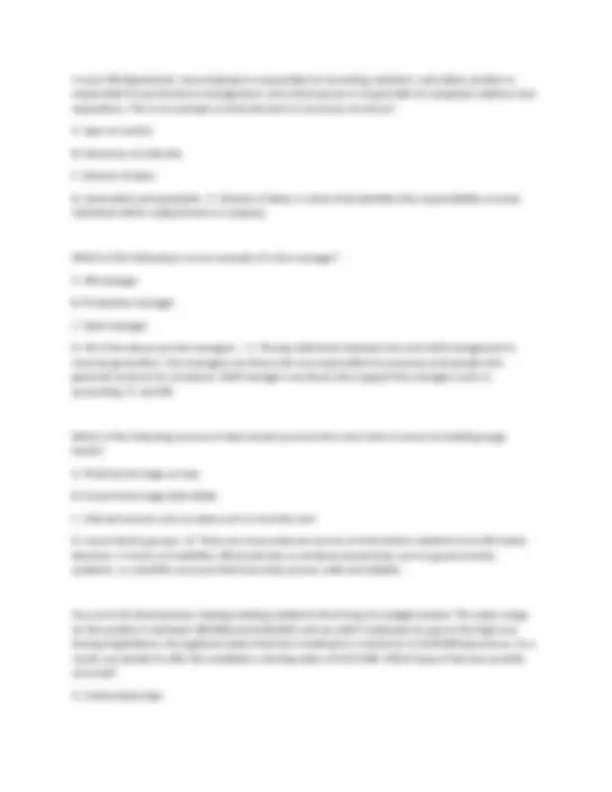
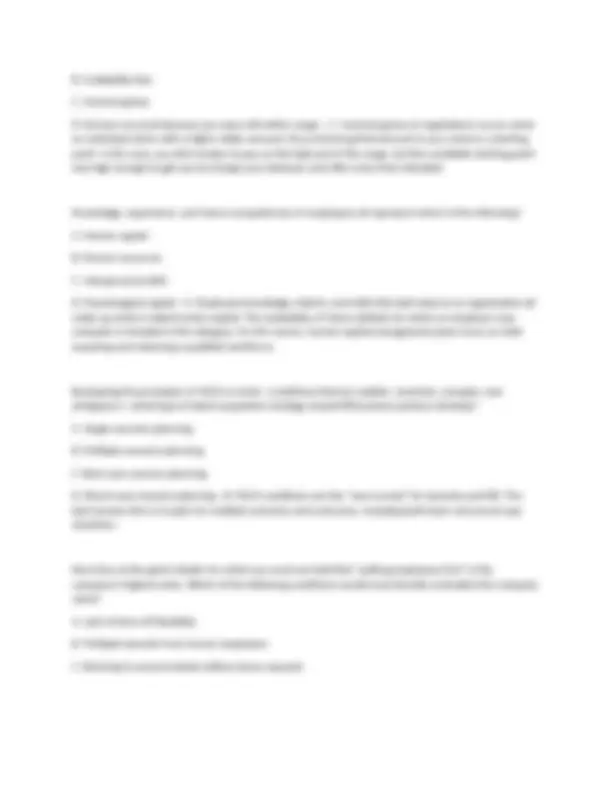
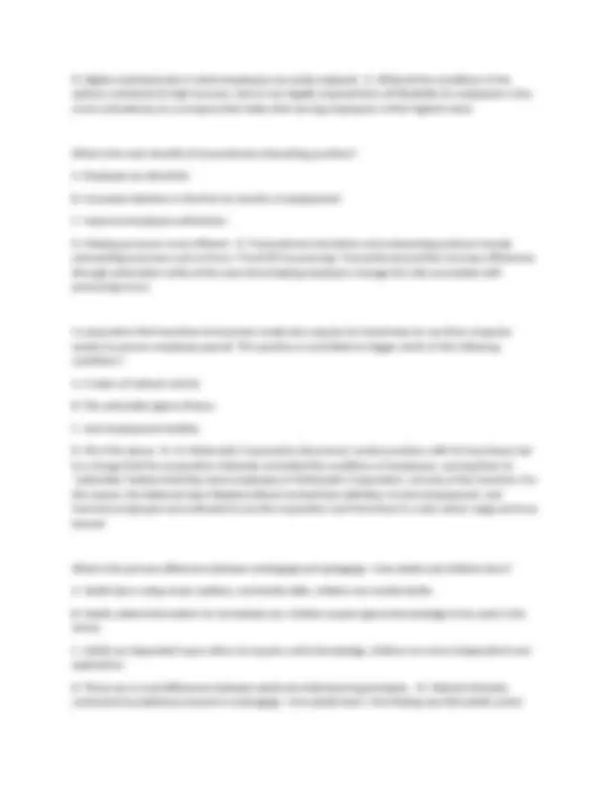
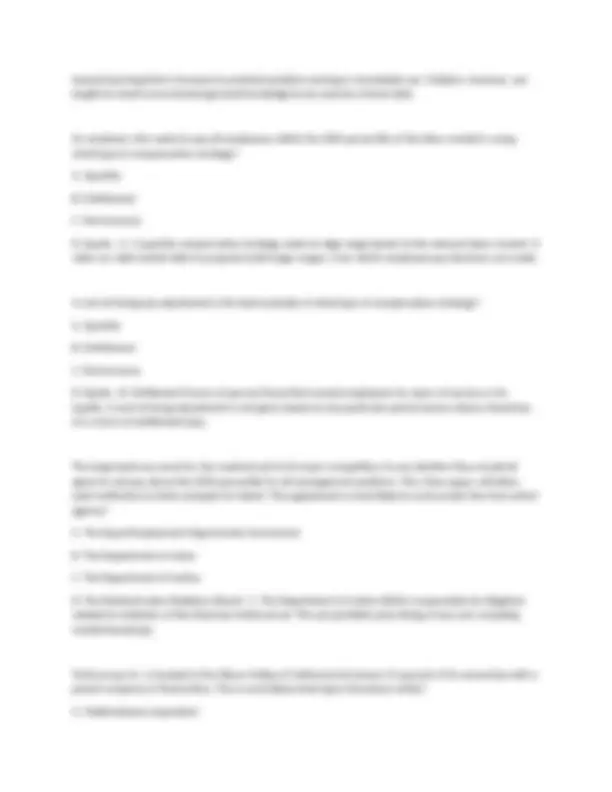
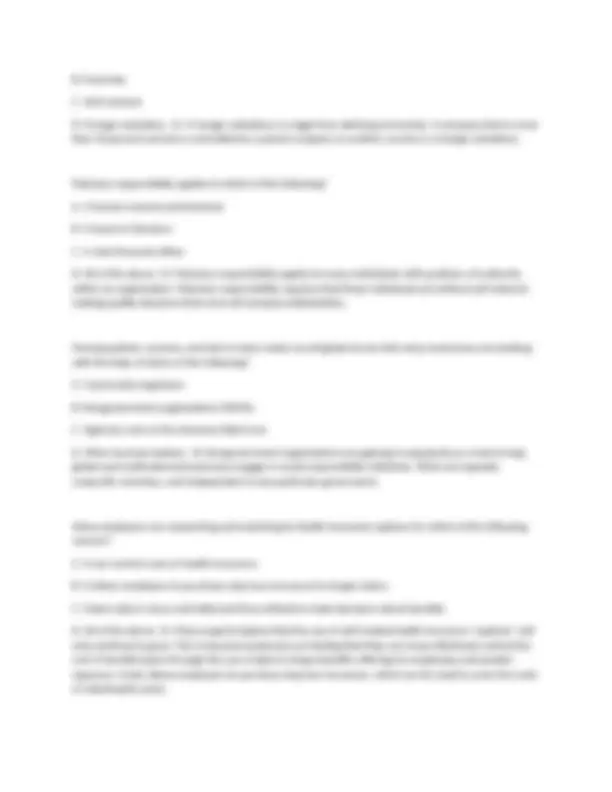
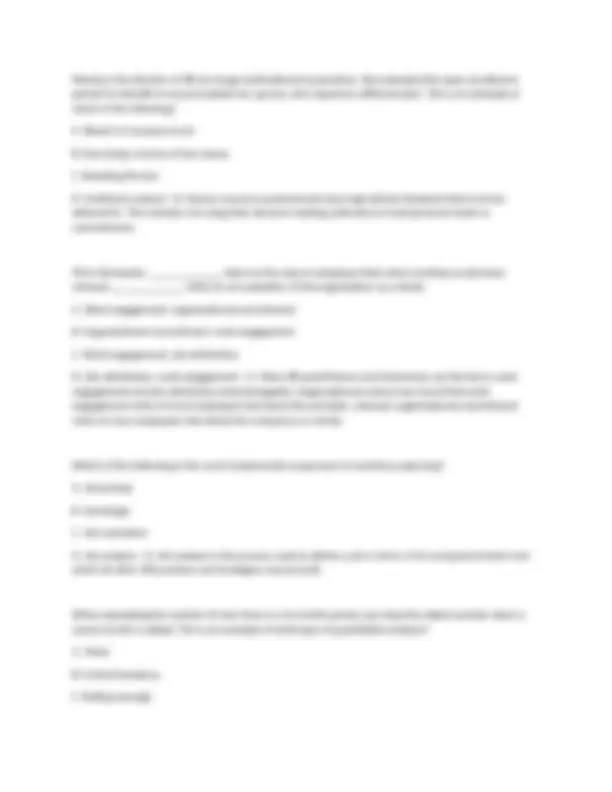
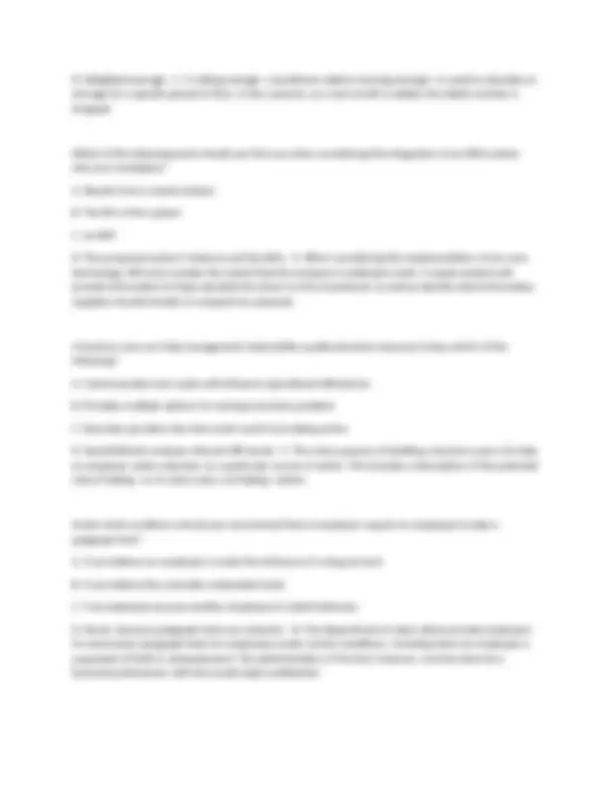
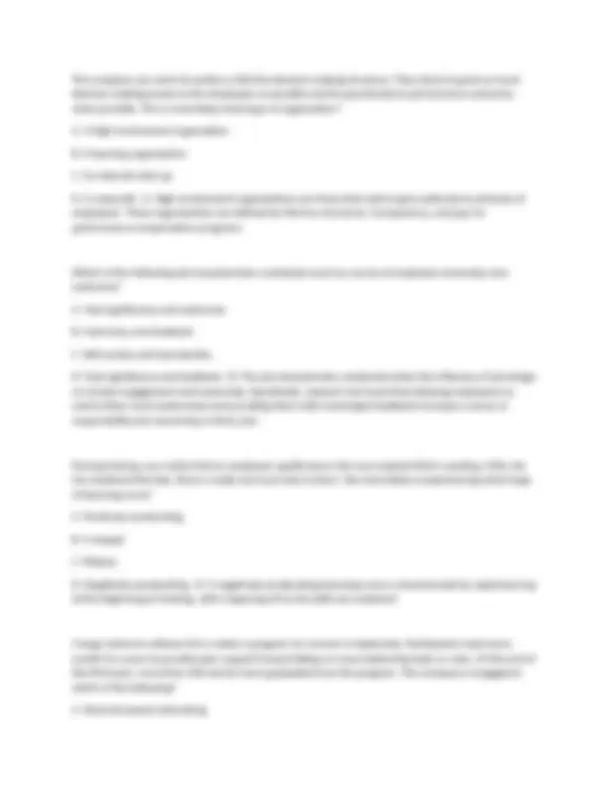
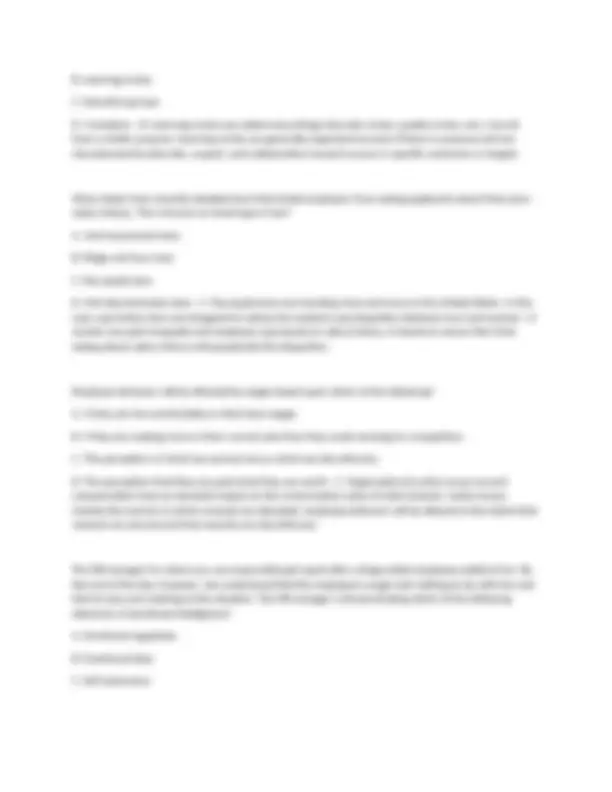
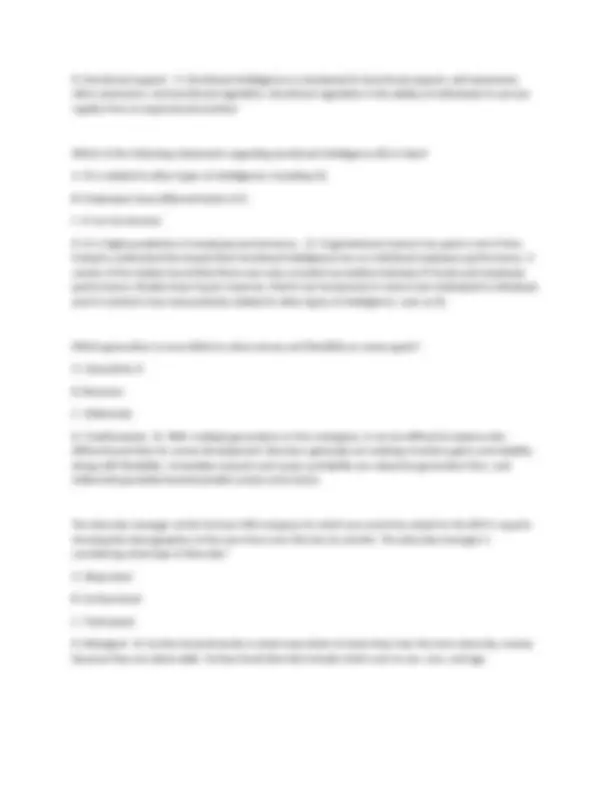
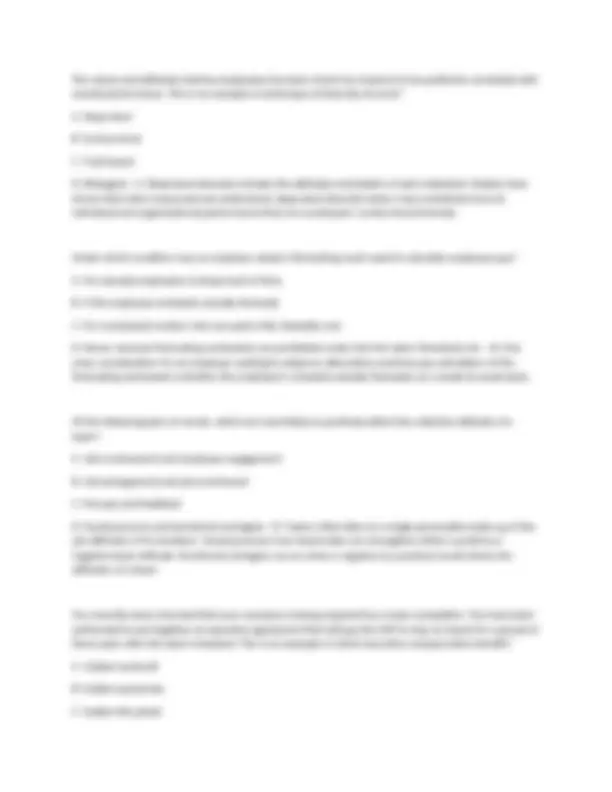
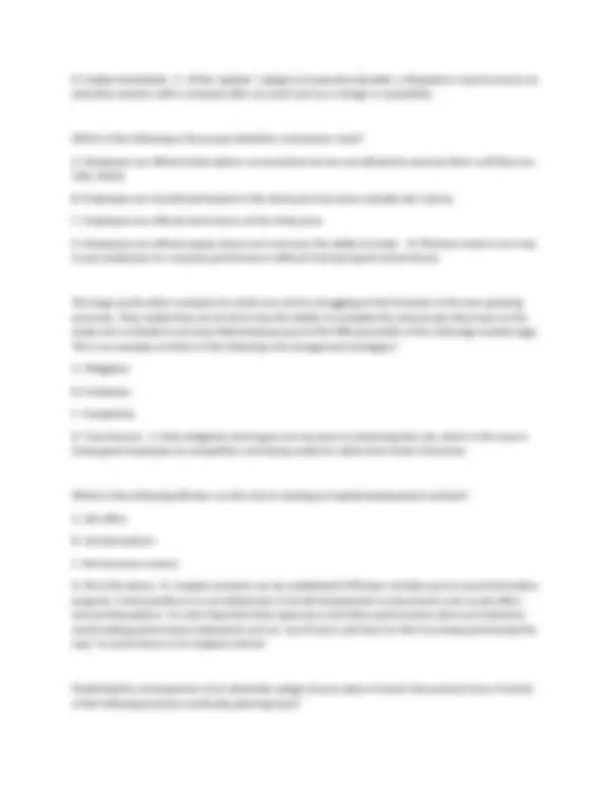
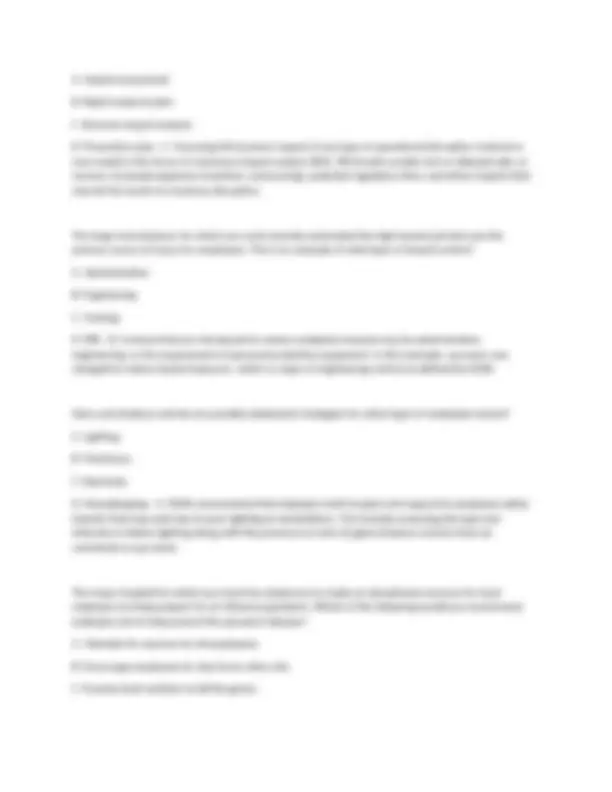
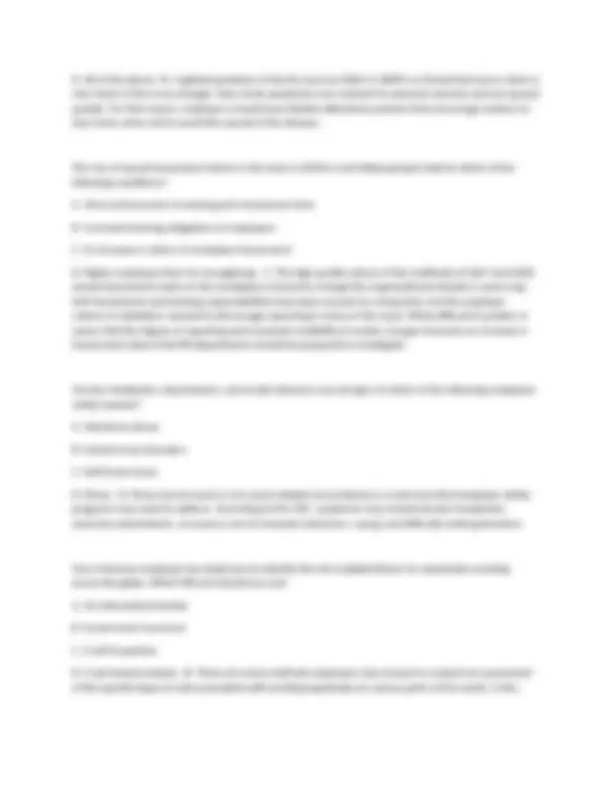
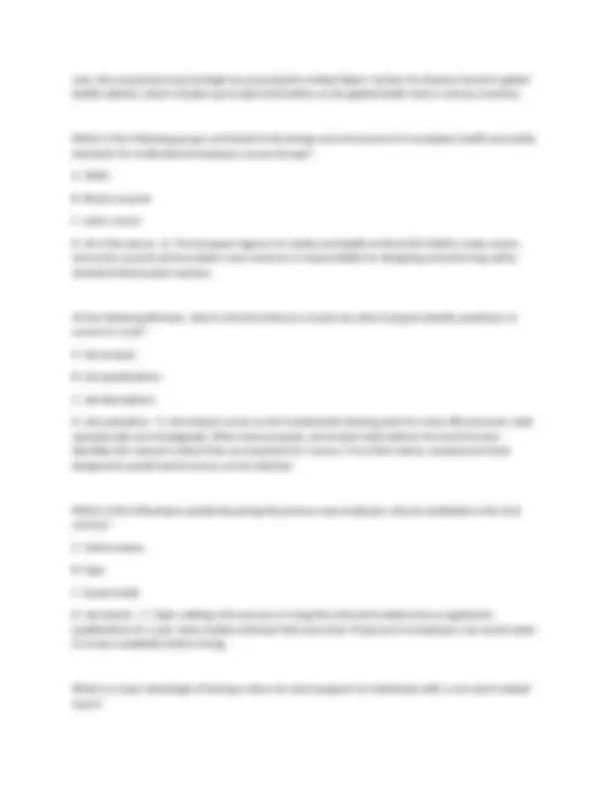
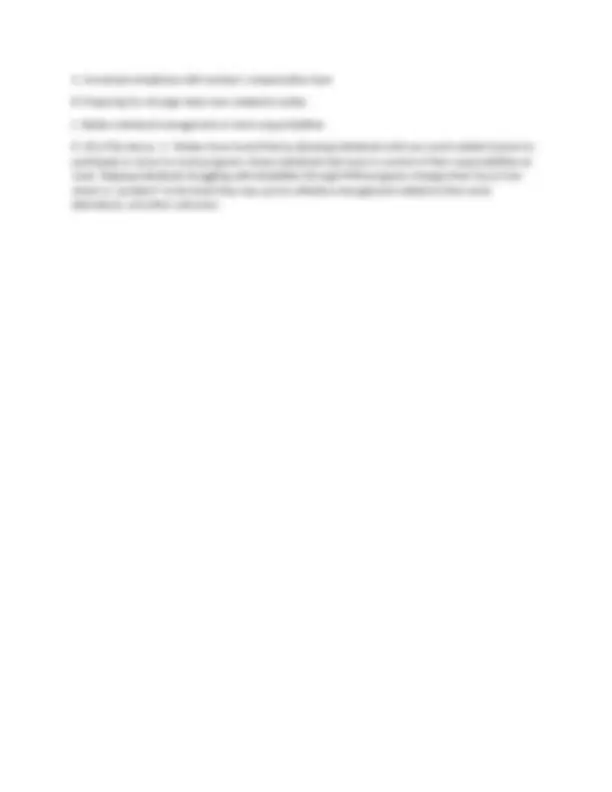


Study with the several resources on Docsity

Earn points by helping other students or get them with a premium plan


Prepare for your exams
Study with the several resources on Docsity

Earn points to download
Earn points by helping other students or get them with a premium plan
Community
Ask the community for help and clear up your study doubts
Discover the best universities in your country according to Docsity users
Free resources
Download our free guides on studying techniques, anxiety management strategies, and thesis advice from Docsity tutors
HRHRCI- SPHR Practice Exam CI 2024
Typology: Exams
1 / 44

This page cannot be seen from the preview
Don't miss anything!





































One of your production managers uses incentives to reward employees for meeting operational objectives. This is the best example of which of the following leadership styles? A. Charismatic leadership B. Transactional leadership C. Laissez-faire leadership D. Authoritarian leadership - B. Transactional leaders are characterized by a "this for that" style. These leaders use both rewards and discipline when necessary to accomplish organizational and departmental objectives. Consensual romantic relationships at work represent what type of risk? A. Intimate partner violence B. Unlawful treatment C. Sexual harassment D. None, because it's consensual - C. Relationships at work, even those that are consensual, have the potential for issues in which HR will have to intervene. This includes the risk of sexual harassment should the relationship become unwanted by either party. The international gas utility company for which you direct HR does not have an organized health and safety program for its workers. What should be your first step? A. Focus on becoming compliant with international, federal, state, and local safety standards. B. Identify the employees who are most at risk and begin safety efforts with them. C. Obtain approval for a company-wide incentive program based on zero accidents or injuries. D. Meet with the workers' compensation brokers to assess the costs of lack of a safety program. See the answer - B. In this high-risk industry, it would be prudent for human resources to begin building a safety program for those workers who are most at risk. This effort may include data collection, incentives, and compliance efforts as part of the overall intervention strategy. The food distribution center for which you work has seen an increase in the number of loading-dock workers reporting ankle injuries. What strategy would be most effective to reduce or eliminate the risk?
A. Require employees to wear high-top steel-toed work boots. B. Review the injury records for patterns of unsafe behaviors. C. Conduct a root-cause analysis with a committee made up of dock workers. D. Ask the occupational clinic to come in and provide safety training. - C. Any time there is an increase in injuries and accidents, HR should take the time to analyze for root causes. From this, hazard abatement strategies may be developed and could include new personal protective equipment requirements or worker training. The major Internet provider for which you are the VP of human resources has just experienced the largest customer and employee data breach in the history of the United States. In an effort to comply with the Securities and Exchange Commission (SEC), you should first do what? A. Evaluate the areas where the company's data is still at risk for hackers B. Research credit monitoring services to offer affected individuals. C. Wait to notify investors until the executive team can sell their shares of company stock. D. Assess the depth of the data breach and notify investors as soon as is practicable. - D. When a data breach of this magnitude occurs, it is important for HR to help the company respond in accordance with governing agencies but also in a manner that protects the interests of both the company and the affected individuals. Which of the following are examples of the physical assets that must be secured to prevent a cybersecurity attack? A. The employees B. The buildings C. The workstations D. The power lines - C. Physical assets such as workstations and servers can be tracked and monitored as part of a company's efforts to prevent cyberattacks on sensitive company and customer data. Establishing a hierarchy of assets helps companies do what when it comes to data protection? A. Identify priorities when it comes to building a robust data security program B. Determine what skills in data security personnel to hire for C. Write policies that protect critical assets D. Purchase external layers of protections, making the data harder to breach - A. Establishing a hierarchy of assets helps a company craft an effective data security program. Building controls for these assets
A winery employs hundreds of seasonal, temporary workers that are processed through a staffing agency. Many of them will be working with hazardous chemicals. Which of the following should you do first to comply with OSHA's hazard communication standard? A. Ask the temporary agency to provide general hazardous material-handling training. B. Ensure that the same protections offered to regular workers are offered to temporary workers. C. Ask the agency to come inspect the facility to ensure it is a safe work environment. D. Communicate with the agency regarding what types of protection will be needed. - D. Both the host company and the staffing agency have responsibilities to ensure the safety of individuals who will be working with hazardous materials. Communicating with the agency allows for a coordination of effort, including the need for protection, training, and verifying that the workers are going to a safe workplace. A software developer in the Midwest has decided to offer voluntary microchipping of their employees. The chips will be medically inserted into the individual's right hand and will allow employees to open doors, clock in, and even make purchases in the company cafeteria. What type of data is being collected? A. Biometric B. Personal C. Identity D. Medical - C. There are several different ways information can be collected, stored, and eventually utilized in a 21st-century workplace. In this example, the company is using microchips to identify employees. Using the information from the previous question, what type of risk is the microchipping employer exposed to? A. Identity theft B. Privacy concerns C. Health risks D. All of the above - D. With implantable technology, there are several types of risk that an employer may need to take steps to minimize. The capabilities and design of the microchip must be reviewed to ensure it does not send information about an employee, unlawfully track employee movements, or cause infection or other health issues. Which of the following mitigation efforts will improve data security? A. Purchasing EPL insurance
B. A computer monitoring system of employee keystrokes C. Writing a policy that prohibits the sharing of passwords D. Not collecting the data at all - C. In risk management, employers may seek to eliminate, mitigate, or transfer the risk. An example of a mitigation effort is one that reduces—but does not eliminate—the likelihood of a data breach. For that reason, an employer policy that prohibits the sharing of employee passwords is the best answer. In the wake of recent workplace violence episodes in the news, your executive team has requested that you put together a written plan that addresses what steps to take should an incident occur at one of your locations. You will most likely need what type of plan? A. Disaster recovery plan B. Incident response plan C. Business continuity plan D. All of the above - B. A written incident response plan can be a critical part of a company's response system should an incident of workplace violence occur. An effective plan should identify manager and employee responsibilities, first responder resources, evacuation and head count procedures, and how to coordinate any media response. Your company has a written plan that details the manual workarounds for the company's accounting and payment systems should there be an emergency. This is an example that would be included in what type of plan? A. Business continuity B. Critical incident C. Disaster recovery D. Injury and illness - A. A business continuity plan will most likely detail an information technology (IT) response to the enterprise system of a company. This is needed to get critical business processes that are based on technology back up and running as soon as possible after an incident. To comply with SEC rules at your place of business, you should do which of the following? A. Link executive pay to monthly performance measures. B. Disclose executive pay rates to all employees. C. Publish the ratio of executive to employee pay to shareholders.
A. Voluntary Protection Program B. Strategic Partnership Program C. Alliance Program D. Consultation Program - A. OSHA's Voluntary Protection Program (VPP) is open to employers that have an effective, well-established safety program. If the employer is accepted into the program, the employer may be removed from routine, scheduled inspection lists. Employers have which of the following obligations with regard to international assignee protection? A. They must carry kidnap and ransom insurance for high hazard areas. B. They have a duty of care to take all reasonable steps to protect their expatriates. C. They must have a written crisis management plan in place. D. Employers have the same obligation for international assignees as they do for home country nationals. - B. Employers have a global duty of care to keep international assignees safe. This obligation may take on many forms, but it generally must account for the unique needs of employees that travel or live abroad as part of their work responsibilities. Why might it be a good idea to work with an insurance broker if a company decides to place employees on international assignments? A. The broker can help build crisis response plans. B. The broker may have connections to negotiate in a crisis situation. C. The broker may have access to international resources should a medical emergency arise. D. All of the above - D. An employer may decide to purchase additional types of insurance to accommodate the unique needs of international employees. Brokers who provide these types of policies often have resources far beyond the administrative, including navigating the need to negotiate should an event occur and medical or emergency travel services for the employee and family members should the need arise. Which of the following strategies would best be served by implementing an RTW program at your place of work? A. The ability to coordinate different types of leave B. Compliance with OSHA standards C. The need to reduce injuries and accidents in the workplace
D. The desire to reduce the overall costs of workplace injuries - D. A return-to-work program is one that returns an injured worker back to the job in a modified capacity. Once the injured employee is working modified duty, his pay comes from payroll as opposed to his wages being part of the overall compensation claim. Under what conditions may an injured worker's pay be reduced when accepting a modified duty assignment? A. Only if the injured worker is temporarily stationed at a job that normally pays a lower rate B. It depends on the laws of the state in which the injury occurred C. Only if they are doing so for a nonretaliatory reason D. All of the above - D. There are some cases where it is entirely reasonable for an employer to pay a temporarily injured worker a lower wage while on a modified duty assignment. Employers that adopt this strategy must take care that no retaliation is occurring and that they are not violating the laws of the states in which the employee was injured. An injured worker has been told by his workers' compensation doctor that he is able to go back to work at full duty. The employee disagrees. What should you recommend? A. Sending him back to a doctor of his choice for a final recommendation B. Discussing an IME with the workers' compensation insurance C. A referral to the company's labor attorney D. Termination of employment if he does not return - B. An independent medical exam (IME) is a useful tool when there is a dispute about an injured worker's abilities. Often binding, it is conducted by a neutral, third-party physician. Collective bargaining is best understood as which of the following? A. Implied contract B. Union responsibility C. Employer responsibility D. Statutory right - D. The process of collective bargaining and the resulting agreement is a right granted to employees by way of specific law. In this example, the National Labor Relations Act granted individuals the right to organize and bargain collectively through a union. Freedom of speech, due process, and workplace safety are all examples of which of the following?
D. Discharge without cause - B. Wrongful discharge—also called wrongful termination—occurs when an employer terminates an employee for an unlawful reason such as discrimination, failing to break the law on behalf of an employer, or exercising their rights granted by law (right to vote, whistleblowing, etc.). In the absence of an employment contract or collective bargaining agreement, when may an employee expect to only be terminated for cause? A. If they are a protected class individual B. If there is a progressive discipline policy in the handbook C. If their behavior was first investigated by management D. None of the above - D. The concept of "just cause" is that employees may expect that employment at will does not apply to them. This condition may be met only when there is an employment contract (written or implied) or when the employee is covered by a collective bargaining agreement. An employee has been terminated for "just cause." Which of the following reasons is most likely? A. The employee refused to forge his boss's signature on a document. B. The employee violated the employer's anti-harassment rules. C. The employee was late because he went to vote in the presidential election. D. The employee was a whistleblower who filed a report of corruption that turned out to be inaccurate.
B. An arbitrator is selected from the American Arbitration Association (AAA). C. There is a written arbitration agreement reviewed by legal counsel. D. All of the above - D. Employers may choose to adopt arbitration practices for many reasons. One is the rising cost of legal fees associated with fighting employment-related disputes. Another is to ensure employees receive due process. Regardless of the reasons, arbitration best practices include a waiver of employee right to sue after an agreement has been settled; the use of a professional, neutral arbitrator; and a signed, written agreement that has been approved by counsel. Which of the following should not be included in an employee's regular personnel file because of privacy concerns? A. Application for employment B. Historical records older than three years C. Medical benefits claims data D. Performance reviews - C. Companies must take steps to address employee privacy concerns in all HR practices. This includes properly storing records that have information related to an employee's medical condition or history. Of the following recognition programs, which is not entitlement-oriented? A. Service awards B. Employee of the month C. Sales awards D. Longevity bonus - C. Employee recognition practices are similar to pay practices in that they can be entitlement-oriented or performance-based. Recognition for sales efforts (quotas, new customers, account retention) is based on employee performance. Multicultural work teams, training, and mentoring systems may all be part of what type of human resource program? A. Diversity program B. Climate program C. Anti-harassment program D. Equal Employment Opportunity program - A. Diversity programs have many components that, when combined, make them an effective tool used to promote a positive organizational culture. These
In a union environment, an employee who believes that he has been unfairly passed over for promotion should file which of the following? A. A complaint B. A grievance C. A charge of discrimination D. A charge of harassment - B. A grievance is a formal written complaint filed when an employee has moved beyond simply feeling dissatisfied. In a union environment, HR and the union will most likely have a formal grievance procedure. An employee is called to his supervisor's office, believing that he will be disciplined. Accordingly, he requests that his union steward be present for the meeting. His supervisor denies the request, violating which of the following employee rights? A. Statutory B. Due process C. Weingarten D. Privacy - C. Named after the court case that established them, Weingarten rights grant covered employees the right to have representation in disciplinary meetings. What recourse is available for an employee who was denied his Weingarten rights and, in the process, was terminated? A. Reinstatement B. The right to sue for criminal damage C. The right to sue for civil damages D. Back pay and reinstatement - D. If an employee is dismissed or otherwise harmed by a decision that violated his rights to representation in disciplinary meetings, he may be entitled to back pay and reinstatement. Which of the following is occurring when a third party settles disputes that occur as the result of differences in the interpretation of a collective bargaining agreement? A. Collective bargaining B. Labor negotiations C. Labor strike
D. Grievance arbitration - D. Grievance arbitration involves a neutral third party to settle disputes that are rooted in different interpretations of a labor contract. This process is different from issues arbitration, which utilizes a neutral third party to settle disputes regarding how a contract will be written. Engineers, nurses, and physicians would most likely belong to what type of union? A. Nongovernmental B. Professional C. Industrial D. Services - B. As a result of the general decline in union membership over the years, unions have targeted specific industries and types of workers. The unionization of professional workers such as nurses and engineers are examples of this. Janitors, building cleaners, and meatpacking workers are examples of which groups targeted by unions over the last several years? A. Low skilled B. Professional C. Contingent D. Part-time - A. Unions have successfully organized low-skilled workers mainly because of the hard work, low pay, and difficult working conditions characterized by these types of jobs. A shift of a union's focus to issues of pay equity and flexible work arrangements is most likely an effort to organize which type of worker? A. Millennials B. Blue collar C. Women D. Liberal - C. The growing percentage of women in the workforce has forced unions to alter their focus on issues that matter to this demographic. These issues include child, paid family leave, maternity leave, pay equity, and flexible work arrangements, just to name a few. Which disciplinary approach establishes the expectation in employees that they will progress through a series of steps when being disciplined? A. Positive
Taylor has been frequently absent from work over the last three months, so much so that she has violated the company's attendance policy. The supervisor has come to you for advice on how to proceed. Which of the following options puts the company at the most risk? A. Discuss with the supervisor the reasons for the absences B. Review with the supervisor any relevant documentation C. Review the days missed to look for trends D. Proceed directly with the discipline - D. At the center of taking any action against a worker is the need to consider employee rights. In this scenario, there are several labor laws that may be applicable for Taylor's case. At this stage, HR's best role is to help the supervisor gather and review as much relevant information as possible before making a decision to proceed with the discipline. Which of the following is the role of a supervisor—not human resources—when disciplining an employee? A. Make the decision to discipline B. Train managers on disciplinary actions C. Design disciplinary procedures D. Understand labor laws related to employee rights - A. HR often serves in an advisory capacity when the need for discipline arises. Generally, it is up to the direct supervisor or manager to ultimately make the decision to discipline their employee. The best discipline could be described as which of the following? A. Training B. Self-discipline C. Progressive D. All of the above - B. Most employees genuinely want to succeed in their work environment. When they clearly understand the behavioral expectations and outcomes, most will apply the proper levels of self-discipline to be successful in their jobs. Chuck has been struggling with having a positive attitude at work. You and his supervisor met with Chuck to make him aware of the behavioral expectations. As a result, Chuck's attitude improves. This approach is a characteristic of which type of discipline? A. Counseling B. Progressive
C. Positive D. Mentoring - C. Positive discipline approaches are characterized by constructive partnerships between the employee, manager, and human resources. The goal is to clearly communicate the expectations for behavior and engage in joint problem-solving. Of the following, which is the most challenging issue when implementing a positive discipline approach? A. Gaining employee buy-in B. Monitoring for consistent practices C. Writing a legally compliant policy D. The time it takes to train managers - D. The positive approach to discipline focuses on joint problem- solving as opposed to a series of progressive consequences of employee behavioral issues. It requires extensive training for managers and supervisors to both understand and apply behavioral science theories such motivation and performance coaching. You are the senior labor relations specialist at your place of work, and the company has an existing progressive discipline policy and practice. Under this policy, which of the following employee offenses would most likely lead to immediate termination? A. Falsifying an employment application B. Insubordination C. Safety rule violation D. Excessive tardiness - A. Progressive discipline policies include a series of steps (verbal, written, final written, etc.) to address employee performance deficiencies. There are certain egregious offenses, however, in which an employee may be immediately discharged. These include falsifying an employment application, theft, and alcohol or drug use at work. Why might a manager be reluctant to discipline an employee? A. Fear of conflict B. Guilt C. Fear of lawsuits D. All of the above - D. There are many reasons managers may hesitate to discipline their employees. Some supervisors are not effective conflict managers, while others may know that they (and others) are guilty of similar offenses. The fear of the company or they themselves being sued may also influence a manager's decision to take corrective action to resolve negative employee behaviors.
D. There is no difference. - C. Policies are general guidelines for both company and employee behaviors. Procedures, on the other hand, are more specific practices of how processes should be completed or systems should be implemented. Your company handbook includes the statement "Employees are prohibited from alcohol use at work." This is an example of which of the following? A. Policy B. Procedure C. Rule D. All of the above - C. A rule is a specific guideline that serves to restrict certain employee behaviors. Often found in the handbook under "Code of Conduct," rules are written so there is very little interpretation needed as to their meaning. Which of the following phrases should be eliminated from a company handbook? A. Permanent employee B. Probation period C. No social media use D. All of the above - D. There are many risks that can be created simply by the language used in a company handbook. The term permanent employee dilutes employment at will, and a probationary period—as opposed to an introductory period—does the same. Prohibiting social media use completely can erode an employee's right to engage in protected concerted activity under the National Labor Relations Act. "This employee handbook is not intended to be part of a contract..." is being used in an employee handbook to preserve which of the following? A. Employee rights B. Employer rights C. Employment at will D. The public policy exception - C. Disclaimers such as the one in the question are used to preserve the nature of at-will employment between the employer and employee. Your company CEO recorded a "state of the company" video and asked you to post it on the company intranet. This is an example of what type of communication?
A. Upward communication B. Downward communication C. Electronic communication D. Digital communication - B. Downward communication flows from executives, managers, and supervisors down to the employees. A safety suggestion system is an example of which of the following? A. Employee survey B. Downward communication C. Upward communication D. Incentive - C. Any type of suggestion system allows an upward flow of communication from employees to management. The large hotel you work for asks guests to complete cards commenting on the level of service they received from the workers. These results are most likely used by human resources to do what? A. Recognize employees B. Discipline employees C. Refine procedures D. All of the above - D. Gathering feedback from both internal and external sources is a critical task for human resources. Feedback can be used to recognize, reward, and discipline employees but also to inform organizational decision-making to improve procedures. Which of the following requires employers to provide jobs and a workplace environment that are free from recognized safety and health hazards? A. An emergency action plan B. The Control of Hazardous Energy standard C. The General Duty standard D. The Hazard Communication standard - C. The General Duty standard emphasizes the need for employers to protect employees from hazards, even in the absence of a specific directive (standard) to do so. In addition, they have a general duty to comply with all applicable standards that pertain to their workplace.